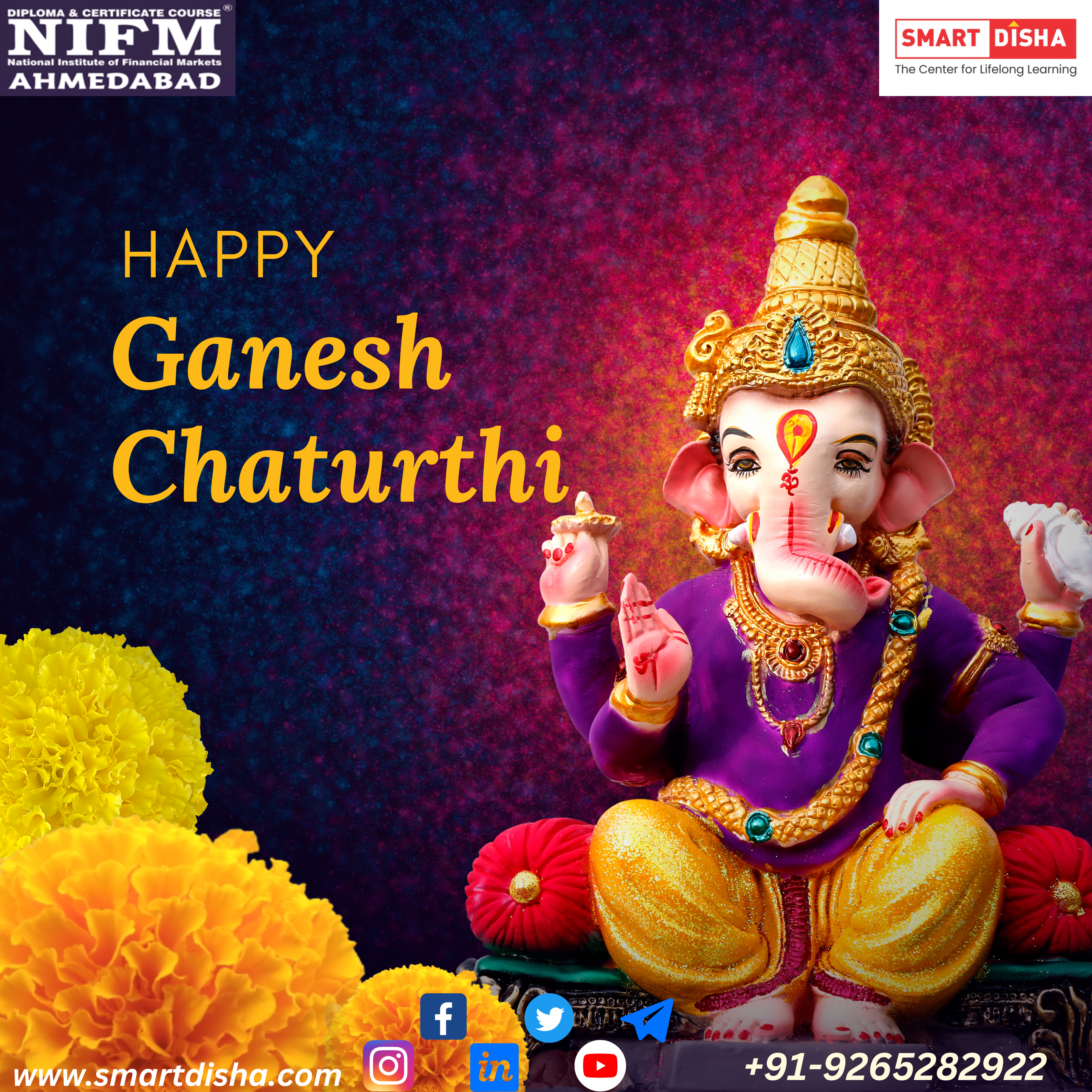Shri Ganesh Chaturthi, also known as Ganesh Puja, stands as one of the most celebrated Hindu festivals dedicated to Lord Ganesha. This vibrant and auspicious occasion typically falls in the months of August or September, according to the Hindu lunar calendar. Devotees enthusiastically prepare to welcome Lord Ganesha into their homes and communities, participating in various rituals, ceremonies, and cultural festivities. In this comprehensive blog, we will explore the essence of Shri Ganesh Chaturthi, its mythological significance, the profound meaning behind Lord Ganesha’s name, the rituals observed by Hindu devotees, the unique symbolism of Lord Ganesha’s form, his teachings for a peaceful and prosperous life, and how these teachings can be applied to excel in the field of long-term stock market trading and investment.
Shri Ganesh Chaturthi (Ganesh Puja)
Shri Ganesh Chaturthi, often referred to as Ganesh Puja, is a significant Hindu festival celebrating the birth of Lord Ganesha, the deity of wisdom, prosperity, and good fortune. It marks the beginning of a ten-day celebration filled with devotion, cultural events, and grand processions. Devotees create clay idols of Lord Ganesha, intricately designed and beautifully adorned, to be placed in homes and public pandals (temporary shrines). The festival concludes with the immersion of these idols in water bodies, symbolizing Lord Ganesha’s return to his celestial abode.
Shri Ganesh Chaturthi finds its roots in ancient Hindu mythology. According to the Puranas, Lord Ganesha was created by Goddess Parvati, the consort of Lord Shiva, using sandalwood paste. She breathed life into the idol and placed him outside her chamber while she bathed. When Lord Shiva attempted to enter, young Ganesha, unaware of his divine lineage, blocked his way. In his anger, Shiva beheaded Ganesha.
Seeing the grief of Goddess Parvati, Lord Shiva promised to bring Ganesha back to life. He replaced Ganesha’s head with that of an elephant, bestowing upon him the name “Ganesha,” which means the Lord of the Ganas (attendants of Lord Shiva). This tale illustrates Ganesha’s role as a protector and remover of obstacles.
Significance of the name GANESH
The name “Ganesha” carries profound symbolism. “Gana” refers to a group, and “isha” means lord or master. Therefore, Ganesha is often referred to as the “Lord of the People” or the “Master of All.” His name signifies his benevolence, accessibility, and his universal role in guiding and helping humanity.
Rituals generally done by Hindu devotees on this auspicious occasion?
Shri Ganesh Chaturthi involves a series of rituals and customs performed by devotees:
Prana Pratishtha: This ritual involves invoking the divine presence into the idol of Lord Ganesha.
Aarti: Devotees perform aarti (ritualistic prayers) to the idol, accompanied by songs and offerings of incense, flowers, and sweets.
Modak Offerings: Modaks, a sweet dumpling considered Lord Ganesha’s favorite, are offered as prasad (divine offering).
Slokas and Mantras: Devotees recite various Ganesh slokas and mantras, such as the Ganesh Gayatri mantra, seeking the blessings of wisdom and intellect.
Om Ekadantaya Vidmahe
Vakratundaya Dhimahi
Tanno Danti Prachodayat
Meaning: “Om, we meditate upon Lord Ekadanta (single-tusked), may Vakratundaya (curved trunk) guide and enlighten us. May he inspire and direct our minds.”
Story behind why we offer duba ghasa (Duba Grass) to Ganesh
The tradition of offering Duba Ghasa, or fresh grass, to Lord Ganesha during Shri Ganesh Chaturthi carries a captivating story that connects us to the deep reverence for nature and its significance in Hindu culture.
In ancient times, during the churning of the cosmic ocean (Samudra Manthan) by the Devas (gods) and Asuras (demons), a divine cow called Kamadhenu emerged. Kamadhenu possessed the extraordinary power to grant any wish. As the story goes, this sacred cow used to graze in the heavenly gardens, and wherever her hooves touched the ground, lush and fertile grass, known as Duba, would sprout.
One day, Lord Indra, the king of the Devas, desired to possess this divine cow and its miraculous power. He approached the sage Vashishta, who owned Kamadhenu, with a proposal. Vashishta, aware of the consequences of granting Indra’s request, refused.
Indra, unable to accept the sage’s refusal, decided to forcefully take Kamadhenu. In her distress, Kamadhenu approached Lord Ganesha, seeking his protection and guidance. Lord Ganesha, known for his deep connection with nature and his role as the guardian of dharma, intervened to resolve the conflict.
Ganesha appeared before Indra and explained the importance of preserving the sanctity of Kamadhenu and the natural world. He emphasized the need for harmony between humans and nature and advised Indra to respect the sacred cow’s presence in the heavenly gardens.
Indra, humbled by Ganesha’s wisdom, agreed to let Kamadhenu stay with sage Vashishta. As a token of gratitude and respect, he offered Duba grass to Lord Ganesha. This act symbolized the recognition of Ganesha’s role as the protector of nature and his teachings on environmental consciousness.
To this day, devotees offer Duba grass to Lord Ganesha during Shri Ganesh Chaturthi as a reminder of the harmony between humanity and the natural world. It signifies our commitment to preserving the environment and recognizing the divine presence in all living beings.
Significance and the story of why Lord Ganesha has the Head of an Elephant on a Human Body?
Lord Ganesha’s distinctive appearance, with the head of an elephant and the body of a human, holds deep symbolic significance. The elephant head symbolizes wisdom, intelligence, and the ability to overcome obstacles, while the human body represents the earthly realm. This amalgamation underscores Ganesha’s role as a bridge between the divine and mortal worlds, guiding humanity through life’s challenges with wisdom and grace.
The story behind Ganesha’s unique form is equally fascinating. According to Hindu mythology, Goddess Parvati, while taking a bath, created Ganesha out of sandalwood paste to guard her privacy. She gave him life and instructed him not to allow anyone to enter her chamber.
As fate would have it, Lord Shiva, unaware of Ganesha’s divine origins, returned home and attempted to enter Parvati’s chamber. Ganesha, committed to his mother’s command, blocked Shiva’s path, resulting in a fierce battle. In a fit of rage, Shiva beheaded Ganesha.
Upon realizing the grave mistake, Lord Shiva and Goddess Parvati were grief-stricken. To console Parvati and rectify the situation, Shiva sent his attendants to bring the head of the first living being they found. The attendants returned with the head of an elephant, which Lord Shiva affixed to Ganesha’s body, bringing him back to life.
This act of grace and love not only resurrected Ganesha but also bestowed upon him the unique appearance that we now associate with the beloved deity. Ganesha’s elephant head represents the highest levels of intellect, wisdom, and the ability to overcome obstacles, while his human body symbolizes his connection to humanity and his role as a guide and protector.
Significances of all body parts of Ganesh along with He holds in His four hands?
Lord Ganesha is often depicted with four hands, each carrying specific symbols:
Modak: In one hand, Ganesha holds a modak, representing the sweetness of knowledge and the rewards of a spiritual journey.
Axe: The axe in another hand symbolizes the removal of attachments and obstacles on the path to enlightenment.
Noose (Pasha): The noose is a reminder that Ganesha captures and binds desires to prevent them from leading individuals astray.
Blessing Gesture (Abhaya Mudra): Ganesha’s fourth hand is in a gesture of blessing, signifying his readiness to grant boons and protect his devotees.
The elephant-headed god’s large ears symbolize his attentive listening, while his small eyes represent his focus on inner vision and introspection.
Each of these symbols conveys profound spiritual messages. The modak encourages seekers to savor the sweetness of knowledge and spiritual insight. The axe reminds us to cut away the attachments that hinder our progress on the spiritual path. The noose signifies the control of desires and impulses, and the blessing gesture offers assurance and protection to those who seek Ganesha’s guidance.
Significance of Broken Tusk ( Teath)
The broken tusk of Lord Ganesha is a significant aspect of his iconography and holds a meaningful story in Hindu mythology. This unique attribute of Ganesha is a result of a dramatic and symbolic incident.
The story of Lord Ganesha’s broken tusk is often associated with the writing of the Mahabharata, one of the most revered Hindu epics. The sage Vyasa, who is credited with composing the Mahabharata, needed a scribe to transcribe the epic as he dictated it. He approached Lord Ganesha with this request, seeking his assistance in writing down the vast text.
Ganesha, known for his wisdom and intellect, agreed to help Vyasa but under one condition. He insisted that Vyasa should recite the verses without interruption. Vyasa, in turn, placed his own condition: that Ganesha should understand the meaning of each verse before transcribing it. Both agreed to these terms, and the writing of the Mahabharata began.
As Vyasa dictated the epic, he composed verses of incredible complexity and depth. Lord Ganesha, with his extraordinary intelligence, could grasp the meaning of these verses almost instantaneously. However, to ensure that Vyasa had time to formulate the next set of verses, Ganesha would occasionally pause by breaking off a piece of his own tusk and using it as a quill to continue writing.
This act of breaking his tusk symbolizes Ganesha’s unwavering commitment to fulfilling his promise to Vyasa. It also underscores his dedication to preserving and transmitting knowledge. The broken tusk represents sacrifice and the willingness to overcome any obstacle to accomplish a noble task.
Moreover, Ganesha’s broken tusk carries a broader message for devotees. It teaches us that imperfections and physical differences do not diminish one’s worth or wisdom. Instead, they can serve as a testament to one’s unique qualities and determination to fulfill a higher purpose.
Significance of Mushika Bahan (Mouse) for Ganesh
The symbolism of Mushika, the mouse, as Lord Ganesha’s vehicle carries profound spiritual significance and imparts valuable life lessons.
In Hindu mythology, the mouse is often associated with restlessness and desires. Just as a mouse scurries about incessantly, the human mind tends to wander and chase after fleeting desires, making it challenging to attain inner peace and spiritual enlightenment.
Lord Ganesha’s choice of Mushika as his vehicle symbolizes his mastery over the human mind and desires. He tames the restless mind, steering it away from the distractions of the material world and guiding it toward a path of righteousness, wisdom, and spiritual growth.
By riding the mouse, Ganesha teaches us that we can overcome the chaos of our thoughts and desires through discipline, self-control, and meditation. The mouse serves as a reminder that we should strive to control our own minds rather than letting them control us.
In essence, Mushika represents the human mind’s journey from restlessness to inner peace under the divine guidance of Lord Ganesha. When we worship Ganesha, we seek his blessings to help us conquer the turmoil within our minds, ultimately leading us toward a life of spiritual fulfillment, success, and prosperity.
We worship LORD GANESH with His Teachings for a Peaceful and Prosperous Life
Worshipping Lord Ganesha offers invaluable life lessons that lead to a peaceful and prosperous existence:
Removal of Obstacles: Ganesha’s primary role is to remove obstacles from one’s path, helping devotees overcome challenges and achieve success.
Wisdom and Intelligence: Ganesha’s elephant head signifies wisdom and intelligence, emphasizing the importance of knowledge in making sound decisions.
Humility: Despite his divine status, Ganesha’s humility in accepting the elephant’s head bestowed upon him by Lord Shiva teaches us to embrace our unique qualities with grace.
Protection: Ganesha’s protective nature inspires confidence and reassurance in his devotees, assuring them that they are cared for.
Blessings and Boons: Ganesha is known for bestowing blessings and fulfilling sincere wishes, making him a source of hope and inspiration.
Applying the teachings of Lord Ganesha to a career in stock market trading and investment can be highly beneficial:
Obstacle Management: Approach challenges and market volatility with a calm and composed mindset, akin to Ganesha’s obstacle-removing nature. Develop strategies to navigate financial obstacles.
Knowledge and Research: Embrace wisdom and intelligence by continuously expanding your knowledge of the stock market. In-depth research and analysis are key to informed investment decisions.
Risk Management: Use Ganesha’s noose as a metaphor for controlling and managing risks. Implement risk management techniques to protect your investments.
Blessings of Success: Seek Ganesha’s blessings for successful trades and investments. Maintain humility and gratitude for your achievements.
Patience and Persistence: Ganesha’s teachings underscore the importance of perseverance. Stay patient and steadfast in your trading strategies, even during challenging times.
Shri Ganesh Chaturthi is a celebration that encompasses not only devotion and cultural significance but also profound teachings that can guide us in leading a peaceful and prosperous life. Lord Ganesha’s unique form, wisdom, and symbolism inspire us to overcome obstacles, master our desires, and strive for spiritual and material success. By incorporating these teachings into our lives, including our careers in stock market trading and investment, we can navigate challenges with wisdom, humility, and resilience, ultimately achieving our goals and prospering in our chosen field. May Lord Ganesha bless you with knowledge, fortune, and the strength to overcome all obstacles on your path to success.
Happy Ganesh Chaturthi and may your life be filled with success and contentment!
Jai Hind
Team
Smart Disha Academy
NIFM Ahmedabad
Smart Disha Algo
No.1 Stock Market Trading Training Academy
Success Mantra at Smart Disha
“Invest FIRST in YOURSELF To Learn STOCK Market”
Starts from Very Basic To Advance Level !!!
Registration is must due to limited Seats.
For Training : 92652 82922
For Algo : 94088 56780 ( Only WhatsApp )
Act opening on IIFL (Rs 5 Per lot ) https://cutt.ly/gGSQ1sV
For News Update Join https://shorturl.at/asxzP
For Research and Algo Study Join https://shorturl.at/dhquw
For Daily Algo Updates https://shorturl.at/DILP3
For Discussion on Algo https://shorturl.at/kNR12
#GaneshPuja #AdvanceTradingCourse #StockMarketAdvancedCourse #AdvancedTradingCourses #SmartDishaAlgorithm #NIFM #NIFMAhmedabad #SmartDisha #Algo #TechnicalAnalysis #PriceAction #PriceActionTrading #PriceActionStrategies #Candlestick #CandleStickPatterns #StockExchangeCourse #Nifty #BankNifty #OnlineClasses #OnlineClassroom #ShareMarket #StockExchange #Stock #Trading #Finance #StockTrading #StockMarkets #Traders #OnlineLearning #AlgoTrading #FundamentalAnalysis #OptionTrading #IntradayTrading #NCFM #NISM #StockMarketTraining




